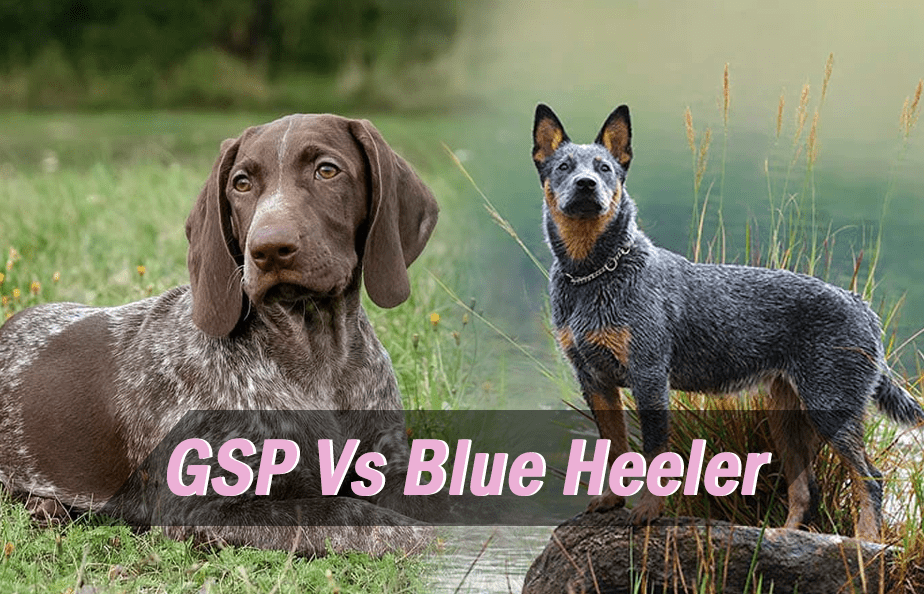Getting the right dog home can be mind-boggling, given the many breeds out there! Few breeds in the dog kingdom are known for their speed, intelligence, and agility. But, what makes the GSP and Blue Heeler or the Australian Cattle Dog so special?
Do you want a dog that is controlling? Or a dog that’s bold and hyperactive? The Blue Heeler and GSP are popular because of their high prey drive, loyalty, and obedience. If you are curious about the two breeds, you may have a couple of questions in mind, such as:
- What are the differences between the German Shorthaired pointer and the Blue Heeler?
- What is the temperament of these two breeds?
- What are their physical and health needs?
- Which breed is more adaptable?
The German Shorthaired Pointer is a gundog bred to retrieve wild game and make good hunting companions. The Blue Heeler is a smart, active, and loyal herding dog that loves companionship and makes excellent watchdogs. Both breeds are distinct in their physical characteristics, temperament, and adaptability.

What is the history and background of the two breeds?
The German Shorthaired Pointer originated in Germany in the 1800s when European hunters desired a versatile breed with powerful hunting abilities.
Many stories revolve around the main breeds that developed the GSP. Still, experts believe that the GSP originated from a cross between the old Spanish pointer and other traditional pointers such as the old German Pointer and Braque Francais.
The breed was perfected because of Prince Albrecht zu Solms-Braunfels and his fellow enthusiasts who worked hard to refine this hunting dog. The GSP is also believed to have the German Bloodhound as one of its ancestors to enhance its scenting ability.
The AKC recognized the German Shorthaired pointer only in 1930, but the first GSP was featured in the German Kennel Stud Book in 1872.
On the other hand, the Blue Heeler was bred for cattle in Australia in the 1800s. Do you know that the Blue Heeler or the Australian Cattle Dog breed is the first successful breed in Australia?
The breed traces its origin to the hard work of a farmer called Thomas Hall from New South Wales. The existing cattle dogs in the 1820s were of English descent, and they were unable to tame the wild beasts of the new colony.
Hence, around the late 1820s, Thomas Hall cross-bred a tamed dingo with blue-colored dogs sent to him by his relatives in Northern England. After repeated backcrossing, Hall successfully developed a powerful cattle breed by 1832.
This breed was popularly known as Hall’s Heelers which became available to other people after Thomas’ death in 1870. The Australian Cattle Dog and the Australian Stumpy Tail Cattle Dog have later developed from this breed. The Blue Heeler reached America in the mid-1900s.
What are the differences between the German Shorthaired Pointer and Blue Heeler?
The two breeds have different lineage and origin stories, but both are super energetic and love to always be on the move. Let us look at how different the breeds are from each other!
Coat
The German Shorthaired pointer has a thick and dense coat that feels rough on the hands. The coat on the underside of the tail is slightly longer, and they have water-repellent coats. This is one of the reasons why GSPs are one of the best swimmers among dog breeds.
The coat of a Blue Heeler is short and thick with a dense undercoat. The coat length is about 1 to 1 and a half inches long, and it is straight and flat-lying. ACDs also have rain-resistant coats making them great herding dogs suitable for all weather.
Color
According to the AKC, the coat color of a GSP can be either a combination of liver and white or solid liver. The common colors are a mix of roan, white, liver, and black.
There are two names given to the Australian Cattle Dog: “Blue Heeler” and Red Heeler,” depending on the color of the coat. The Blue Heeler has a bluish mottled coat with tan, black or blue markings on the head.
Lifespan
The GSP has a shorter lifespan as compared to the Blue Heeler. The average lifespan of a GSP is 10-12 years, whereas, for a Blue Heeler, it is 12-16 years.
Physical characteristics
According to the AKC, the average breed standards of the two breeds are given below:
German Shorthaired Pointer
Height:23-25 inches (male)
21-23 inches (female)
Weight: 55-70 pounds (male)
45-60 pounds (female)
Blue Heeler or Australian Cattle Dog
Height: 18-20 inches (male)
17-19 inches (female)
Weight: 35-50 pounds
The GSP is taller and has a heavier build than the Blue Heeler. This makes sense since the GSP was bred to be actively running on all terrains, searching for animals and birds.
A striking difference between the two breeds is the shape of their ears. The Shorthaired Pointer has long and droopy ears, while the Blue Heeler has pointy and erect ears.
The tail of a Pointer is held straight out from the body that forms a line with the entire body, while a Heeler’s tail is mostly hanging downwards. The eye patches on a Blue Heeler are also distinctive of the breed.
Which breed is more adaptable?
Do you want a dog to live with you in your apartment? Or do you want a dog as a companion on all your adventurous trips? Well, when it comes to adaptability, both breeds score moderate in that regard.
The GDSP and ACD are highly energetic and super active dogs that love to chase and run anywhere. They will not thrive well in an apartment living lifestyle because they will easily become bored. And we all know that a bored dog is a destructive and unhappy dog!
But, for houses that have a spacious backyard or a farmhouse, both breeds are excellent! The GSP can accompany you for all hunting trips wherever, while a Blue Heeler can take care of your home.
The Blue Heelers excel as herding dogs and become good guard dogs and loyal companions at home. They have a protector’s instinct and will do anything to save their masters. In contrast, the GSP will follow your commands and go with you everywhere.
Both breeds thrive best in mild weather, and anything extreme can cause discomfort. They are not adaptable to extremes of temperatures but will fare better in hot climatic conditions than in the cold.
But if you ask which breed is more adaptable? The GSP seems to be slightly better at adapting to new environments than a Blue Heeler. This is also because GSPs are used to exploring new places and figuring things out in the wild, just like their ancestors.
They are also good with children and other pets compared to the Blue Heeler. It will take longer for a Blue Heeler to make new friends than for a GSP.
What is the temperament of these two breeds?
The German Shorthaired Pointer and the Blue Heeler are both loving and affectionate dogs that can make great family dogs. There are many factors at play that affect a dog’s temperament, such as hereditary, socialization, and training.
If you look at the hereditary factors of both breeds, they were both bred to make great companions. One breed was for a hunting companion, while the other was a companion to the farmers. Hence, it is safe to say that both breeds are people-lovers.
But, the GSP can be needier than the ACD. GSPs are popularly known as “Velcro dogs” because they like sticking to people they love. They are cuddly and super clingy and can laze in bed with you all day.
They hate being alone and will become restless and unhappy if left alone for long. Some may even resort to destructive behavior if they don’t get the attention they need.
The Blue Heeler in this regard is much better in this regard because they can be alone even for long hours. They are independent thinkers and fearless, and since they love to protect, they can guard your house when you are not home. This is one reason why they are kept as watchdogs in many families.
However, the Blue Heeler is not very kid-friendly like the GSPs, and neither are they pet-friendly. Blue Heelers are cautious and defensive in front of strangers, but the GSP is not so. GSPs can get along with strangers and other pets too.
However, remember that both breeds have strong hunting instincts, and so they love to chase and prey on small animals. It’s always advised to take them out on a leash during walks.
What are their physical and health needs?
Suppose you are a workaholic or feel that you may not be able to devote enough time to your pets, then a GSP and Blue Heeler aren’t the breeds for you! You know how hyperactive and energetic both breeds are; hence they can be pretty demanding!
These breeds need their daily dose of rigorous exercise to keep their muscles and joints strong and healthy. Half an hour daily won’t be enough to fulfill their physical needs. At least an hour of heavy training or physical activity is necessary.
Remember that if these dogs don’t get their mental and physical stimulation every day, they are prone to mental illnesses too. Depression and anxiety have become common problems among dogs these days.
The GSP and the Blue Heeler are generally healthy dogs and will remain healthy most of their lives with regular health check-ups. Gastric torsion is a more common issue seen in deep-chested dogs such as the GSP.
The ears of the Blue Heeler are prone to infections since they are erect and open. Hence, proper clean-up of the ears to remove any build-up wax is essential.
German Shorthaired Pointer Vs. Blue Heeler- which one to choose?
If you wonder which of the two breeds is the right choice for you, you have come to the right place! There are a couple of things you must ask yourself when deciding on the breed-
- Why do you need a dog?
- How much time can you give your dog?
- Do you have other pets at home?
If you want a dog to guard your house and family, then a Blue Heeler is the perfect choice for you! But, if you want a hunting companion or a dog to sleep with you all day, then a GSP will be a better choice.
Both the breeds are intelligent and super energetic, so you need to have spacious space to make them play and run about. But, if you don’t have that, then make sure you commit to taking them out for a good run or training at least once daily.
Blue Heelers will guard your property very well when you are out. A GSP won’t be happy being left alone for long, while the Blue Heeler will happily do so. Also, you must consider if you have long working hours.
Overall, both the GSP and Blue Heeler are intelligent and friendly dogs who can get along with any home if they get love and care.
Conclusion
Being a dog owner is not just a privilege but a responsibility! Hence, knowing your pet’s health and physical needs is paramount to keeping them healthy and happy.
The GSP may not be suitable for beginners since they can be a handful, but a Blue Heeler is more manageable. They are both obedient and loyal dogs who can learn commands quickly.
The GSP is more popular than the Blue Heeler because of its high intelligence and easier trainability. But, the Blue Heeler is one of the best guard dogs in the dog kingdom.

